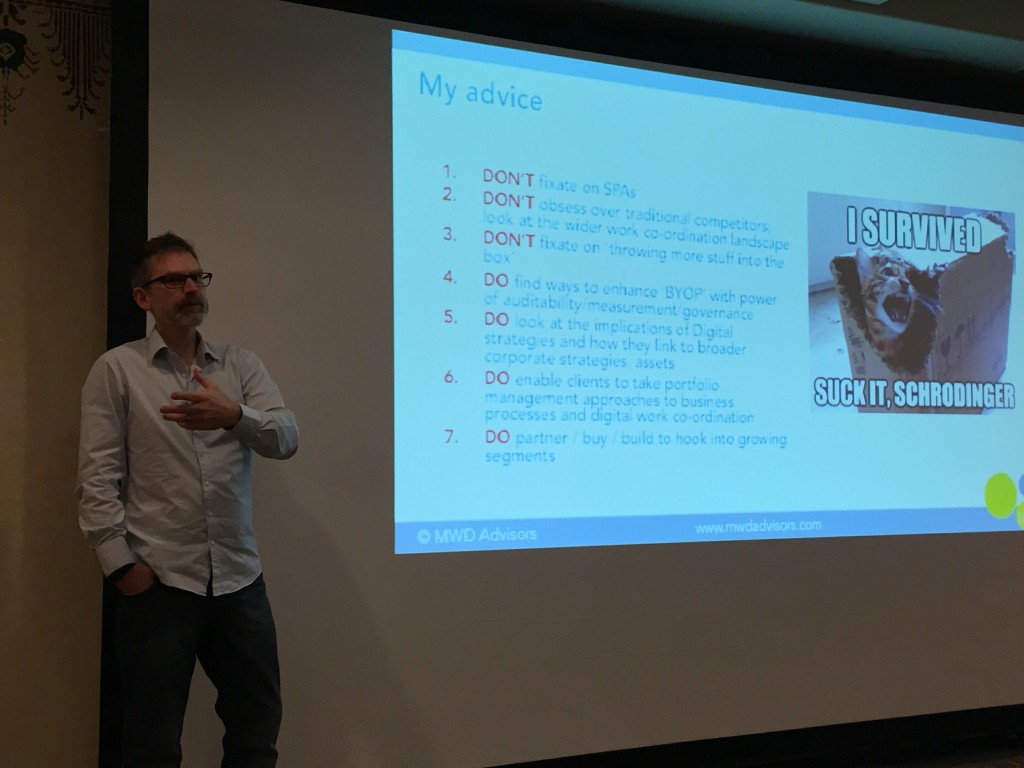It’s the last (half) day of bpmNEXT 2015, and we have five presentations this morning followed by the Best in Show award. Unfortunately, I have to leave at lunchtime to catch a flight, so you will have to check the Twitter hashtag to see who won — or maybe I’ll do a wrapup post from the road.
IBM: BPM, say Hello to Watson. A New Era of Cognitive Work – Here Today
First up was Chris Vavra discussing how Watson and cognitive computing and natural language analysis capabilities can be used in the context of BPM, acting as an expert advisor to knowledge workers to enhance, scale and accelerate their work with its (or as Chris said, “his”) reasoning capabilities. There are a number of Watson services offered on their Bluemix cloud development platform; he demonstrated an example of an HR hiring process where the HR person uses Watson to analyze a candidate’s personality traits as part of the evaluation process. This is based on a written personal statement provided by the candidate; Watson analyzes that text (or could link through to a personal website or blog) to provide a personality analysis. From the Bluemix developer dashboard, you can create applications that include any of the services, including Watson Personality Insights that provides ranking on several factors in the five basic personality traits of Openness, Conscientiousness, Extraversion, Agreeableness and Emotional Range, with a graphical representation to highlight values and needs that may be of concern in the hiring process. It’s unlikely that a hiring manager would use solely this information to make a decision, but it’s interesting for exploring a candidate’s personality characteristics as part of the process. There are a number of other Watson-based services available on Bluemix to bind into BPM (and other) applications; in the IBM cloud BPM designer, this just appears as a service connector that can be configured with the Watson authentication information, and invoked at a services step in a process flow. Lots of other potential applications for bringing this level of expert recommendations into processes, such as healthcare condition diagnoses or drug interactions.
Safira: Managing Unstructured Processes with AdHoc BPM Framework
Filipe Pinho Pereira addressed the issue of the long tail of organizations’ processes, where only the high-volume, high-value structured processes are being implemented as full BPM projects by IT, and the long tail of less critical and ad hoc processes that end up being handled manually. Using IBM BPM, he demonstrated their Ad-Hoc BPM Framework add-on that allows a business user to create a new ad-hoc process based on a predefined request-intervention process pattern, which has only an initial data capture/launch step, then a single “do it” human step with a loop that keeps returning to the same step until explicitly completed. The example was an expense report process, where a blank expense spreadsheet was attached, a form created to capture basic data, and SLAs specified. Routing is created by specifying the primary recipient, and notifications that will be issued on start, end and SLA violations. Users can then create an instance of that process (that is, submit their own expense report), which is then routed to the primary recipient; the only routing options at that point are Postpone, Forward and Complete, since it’s in the main human task loop part of the process pattern. This distills ad-hoc processes to their simplest form, where the current recipient of the main task decides on who the next recipient is or whether to complete the task; this is functionally equivalent to an email-based process, but with proper process monitoring and SLA analytics. By looking at the analytics for the process, we saw the number of interventions (the number of times that the human step loop was executed for an instance), and the full history log could be exported to perform mining to detect patterns for process improvement. Good example of very simple user-created ad hoc processes based on an industrial-strength infrastructure; you’re not going to buy IBM BPM just to run this, but if you’re already using IBM BPM for your high-volume processes, this add-on allows you to leverage the infrastructure for the long tail of your processes.
Cryo: Tools for Flexibility in Collaborative Processes
Rafael Fazzi Bortolini and Leonardo Luzzatto presented on processes that lie somewhere in the middle of the structured-unstructured spectrum, and how to provide flexibility and dynamic aspects within structured constraints through decision support, flexible operations, ad-hoc task execution and live changes to processes. Demonstrating with their Orquestra BPMS, they showed a standard process task interface with the addition of localized analytics based on the history of that task in order to help the user decide on their actions at that point. Flexible routing options allow the user to return the process to an earlier step, or forward the current task to a colleague for consultation before returning it to the original user at the same step; this does not change the underlying process model, but may move the instance between activities in a non-standard fashion or reassign it to users who were not included in the original process definition. They also have an ad-hoc process pattern, but unlike Safira, they are using actual ad-hoc activities in BPMN, that is, tasks that are not connected by flow lines. Users are presented with the available ad hoc tasks in the process model, allowing them to “jump” between the activities in any order. They also demonstrated live changes to production processes; the examples were adding a field to a form and changing the name of a task in the process, both of which are presumably loaded at runtime rather than embedded within the instantiated process to allow these types of changes.






